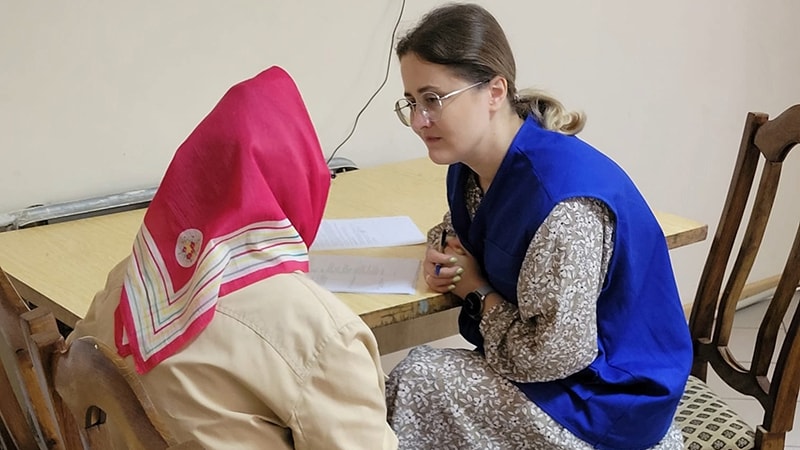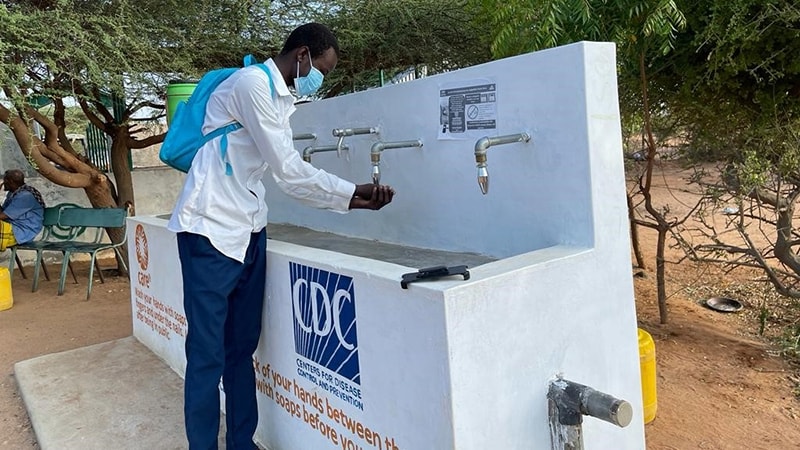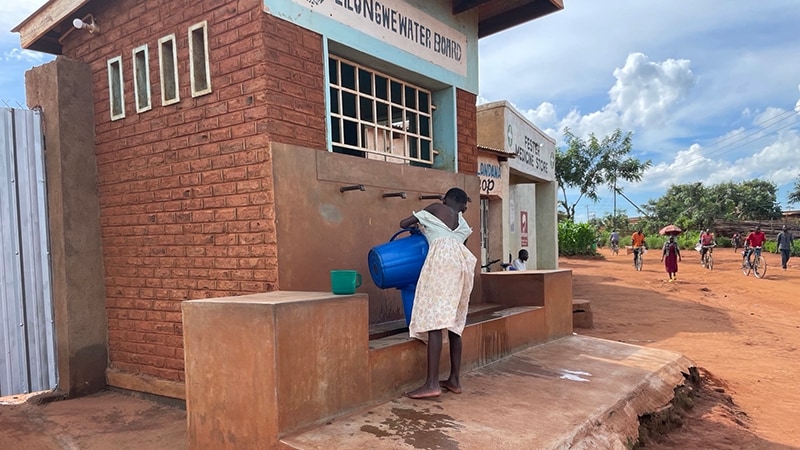At a glance
August 19 is World Humanitarian Day. Each year, CDC recognizes the contributions and sacrifices made by humanitarian workers around the world, including CDC responders.

Overview
The UN Refugee Agency estimates that 117 million people were forcibly displaced worldwide in 2023. Reasons included persecution, conflict, violence, human rights violations, and events seriously disturbing public order.
When disaster strikes, CDC experts work with partners around the world to help those impacted and strengthen public health globally. This work happens before, during, and after humanitarian emergencies. CDC provides public health expertise and uses evidence-based approaches to guide response efforts.
The examples below demonstrate how CDC provides expertise in global humanitarian crises around the world.
War in Ukraine

Russia's war in Ukraine has displaced one third of Ukraine's total population. The resulting humanitarian crisis triggered significant information gaps on healthcare needs across Ukraine, particularly among refugee populations. The crisis has also “super-charged” the spread of infectious disease threats, particularly highly virulent antibiotic-resistant organisms. Antibiotic-resistant bacteria exported from Ukraine have been detected across Europe and as far as Japan, illustrating the World Health Organization’s (WHO) designation of AMR as a top global health threat. The crisis continues to affect Ukraine’s infrastructure, economy, and health system.
At the start of the war, CDC experts activated a program level incident management structure with the CDC Ukraine Country Office and Eastern Europe and Central Asia Regional Offices to respond to the Ukraine regional crisis. Since 2022, CDC has supported the Government of Ukraine to combat the threat of antimicrobial resistance (AMR) among Ukrainian civilians and soldiers through a facility- and systems-level approach. CDC currently supports multiple approaches to mitigate the effects of these bacteria at the national level as well as among 3 hospitals and 3 regional public health centers in Western Ukraine. Plans are underway to more effectively reduce the spread of AMR by expanding efforts closer to the frontlines. Reducing the spread of AMR will immediately protect the health of Ukrainian civilians and soldiers and ultimately reduce the likelihood of further geographic spread.
CDC also continues to work with field epidemiology trainees to strengthen, inform, and guide actions to improve health and healthcare access among Ukrainians affected by the ongoing war.
CDC staff continue to provide critical training and assistance in:
- Nutrition and maternal and child health
- Emergency surveillance
- Needs assessments
- Data analytics and reporting
- Risk communication and community engagement
- Risk reduction of waterborne illnesses
Supporting Ukraine's Children after Hospital Blast
Greater Horn of Africa crisis

People in the greater Horn of Africa are facing the worst drought in 70 years. Millions of people face severe food insecurity stemming from conflict, climatic shocks, economic impacts of COVID-19, and the rising cost of food. The crisis is further complicated by outbreaks of infectious diseases, high rates of acute malnutrition, displacement, limited or reduced access to populations, limited access to health care, and severely underfunded response.
CDC uses lessons learned from previous programmatic and famine response experience to provide critical cross-cutting technical assistance to CDC country offices and global partners. Partners include the United Nations Children's Fund (UNICEF), World Health Organization (WHO), and United Nations (UN) Refugee Agency.
In Kenya, CDC worked with the Cooperative for Assistance and Relief Everywhere (CARE) International to install handwashing stations, increase access to safe drinking water, and strengthen water, sanitation and hygiene (WASH) services in the Dadaab refugee complex. In Ethiopia, CDC is working closely with partners to develop data-driven models that can assist in prioritizing treatment for children most at risk of death from acute malnutrition.
Global cholera outbreaks
Since 2021, there has been an unprecedented surge in cholera outbreaks across Africa and Asia, representing a resurgence or new introduction of Vibrio cholerae in the affected countries. Overall, 30 countries are experiencing outbreaks of cholera. In Africa, Malawi saw its largest documented outbreak ever in 2022 and 2023, and the Malawi outbreak spread to Mozambique, Zambia, Zimbabwe, and South Africa. Haiti experienced a resurgence of cholera in the Americas after 3.5 years of not reporting a case. In the Eastern Mediterranean, Syria has faced a large outbreak, and Lebanon had its first outbreak in over 30 years.
Humanitarian crises often exacerbate the threat of infectious disease outbreaks such as cholera. Conflict, displacement, and poor access to safe drinking water, sanitation and hygiene may lead to increased spread of cholera and hamper control efforts.
CDC WASH experts supported responses to cholera outbreaks in Malawi, Mozambique, Zimbabwe, Kenya, Lebanon, and Haiti. CDC is also working with partners in Burkina Faso and Kenya to improve access to safe water, sanitation, and hygiene services for refugees and internally displaced persons (IDPs).

